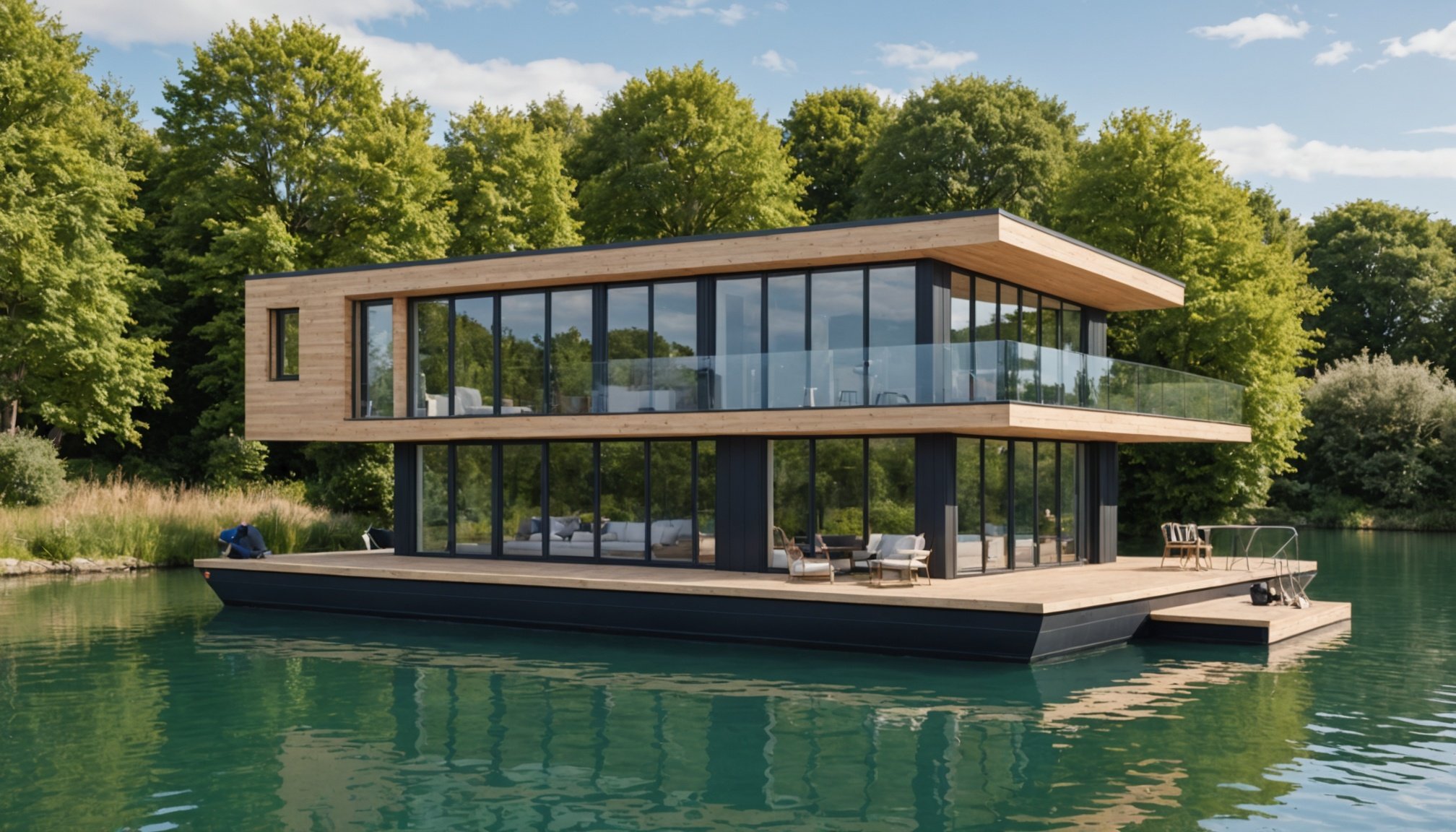Overview of Floating Home Investments
Floating homes are a fascinating segment of the UK real estate market. Unlike traditional land-based homes, these dwellings are designed to rest on water, offering residents a unique living experience. They feature the comforts of a regular home, often including multiple bedrooms and modern amenities, while providing stunning waterfront views and a serene environment.
Recently, the trend for floating homes has been gaining momentum in the UK. This is partly due to the growing desire for sustainable living options and a reduction in urban congestion. As a result, floating homes are becoming increasingly prevalent in various locations, from the bustling Thames to the tranquil Loch Lomond.
Also to see : Navigating Zoning Hurdles: Understanding Mixed-Use Developments in Bristol
From an investment perspective, floating homes present several economic advantages. The investment potential of floating homes primarily stems from their affordability compared to traditional real estate. Additionally, they have lower maintenance costs, thanks to their innovative construction and materials. Furthermore, floating homes are less susceptible to market fluctuations, providing investors with a relatively stable asset.
Investing in floating homes not only holds the promise of financial return but also advocates for an eco-friendly lifestyle. With the trend on the rise and a plethora of economic benefits, floating homes continue to carve their own niche in the real estate industry.
This might interest you : Essential Risk Mitigation Strategies for Property Investors in the UK”s High-Seismic Areas
Environmental Considerations
Exploring the intersection of climate change and coastal living, floating homes may offer a sustainable alternative. With escalating sea levels and more severe weather patterns, traditional homes face increased vulnerability. But how do floating homes fit into this landscape? Floating homes offer sustainability by aligning with natural water movements without contributing to land erosion. These structures adapt to changing water levels, offering a potentially long-lasting living solution amidst climate uncertainties.
Floating homes boast several environmental impact benefits by utilizing eco-friendly materials and energy-efficient systems. For instance, many employ solar panels and rainwater harvesting systems, reducing dependence on conventional energy sources and minimizing carbon footprints. Furthermore, these homes often incorporate green roofs and walls, promoting biodiversity and improving air quality.
However, potential environmental risks cannot be overlooked. Improperly designed floating homes can lead to water pollution and habitat disruption. It’s crucial to implement robust waste management systems and ensure floating homes’ designs harmonize with local ecosystems. Understanding these elements allows homeowners and developers to address climate challenges while reducing the overall environmental impact. Hence, embracing a sustainable lifestyle in floating homes encourages taking action toward a greener future.
Financial Aspects of Floating Home Investments
Floating homes present unique financial analysis opportunities for potential investors. When considering an investment, it’s crucial to weigh both initial costs and ongoing expenses associated with these properties.
Initial costs for floating homes can be significantly higher than those for traditional houses. This is often due to the specialised construction and mooring requirements. Additionally, ongoing expenses such as maintenance fees, insurance, and potential docking costs must be taken into account.
Compared to traditional real estate, the return on investment for floating homes can vary greatly. While some may find these unique properties as profitable due to high demand from niche buyers, others might face challenges in resale value. This makes it essential to thoroughly understand market dynamics and potential buyer interest when evaluating ROI.
Furthermore, investment risks are heightened by environmental factors, such as climate change. Rising water levels can affect the lifespan and structural integrity of floating homes, posing potential financial risks. Moreover, regulations around water-based properties can be stringent and may alter over time, impacting investment stability.
Ultimately, a well-rounded financial analysis is vital to navigating the complexities of floating home investments, ensuring that investors make informed choices that balance potential rewards with inherent risks.
Regulatory Challenges
Navigating the UK’s regulatory landscape for floating homes can be intricate yet rewarding. The heart of this complex journey is understanding specific regulations designed to manage and control such developments. Key to this is the alignment with established zoning laws, which delineate the boundaries for where floating homes can be feasibly located. These laws are crucial as they shape the potential success of floating home investments, ensuring they are situated in permissible and sustainable areas.
One of the formidable tasks investors face is handling the various permits and fulfilling all legal requirements necessary to embark on this innovative housing venture. This involves coordinating with local planning authorities to ensure compliance with environmental and infrastructural standards. Comprehension and adherence to zoning laws are fundamental in this process, as these guidelines dictate permissible locations and conditions for construction.
For potential investors, familiarising oneself with the intricate details of these regulations and necessary permits offers a substantial advantage. It’s imperative to engage with local councils and regulatory bodies early to navigate any foreseen hurdles. By doing so, investors can mitigate risks and align their projects with the overarching legal frameworks, paving the way for successful floating home developments.
Market Trends in Floating Homes
The market analysis for floating homes reveals a growing buyer interest over traditional homes. This shift is largely attributed to increasing environmental awareness and the search for sustainable living solutions. As people become more conscious of climate change impacts, the demand for eco-friendly housing options is on the rise.
Investors are paying close attention to investment trends associated with floating homes. These homes not only present a unique lifestyle but also offer potential advantages in regions prone to flooding. The attractiveness for investors lies in the adaptability of floating homes to various environmental conditions, making them a resilient option in the face of climate uncertainties.
Currently, it’s observed that traditional homeowners are gradually participating in this growing interest, seeking floating homes as either primary residences or vacation retreats. This reflects a broader acceptance and appreciation of water-based living.
In the future, the outlook for floating home investments is set to become even more promising. As climate change continues to influence living conditions globally, buyers and investors will likely see floating homes as a viable alternative. This could shape an exciting era for both markets, merging sustainability with innovative housing solutions.
Case Studies and Expert Opinions
Exploring floating homes in the UK, we find several fascinating real-life examples. These case studies showcase how innovative designs can effectively integrate into challenging environments. One such success story is London’s Floating Village, featuring homes near the iconic Thames, proving successful and garnering attention.
Providing expert insights, leading architects and urban planners emphasize the possibilities and challenges presented by floating homes. Experts note the often-discussed market viability, explaining these structures’ unique appeal amidst urbanisation pressures. They convey optimism, although not without caution regarding the inherent risks, such as construction quality and environmental impact.
What lessons can be learned from existing floating home investments? Financial analysts highlight the importance of due diligence, pointing out that potential investors must thoroughly research project specifics, including location and design. These investments vary, with some gaining value while others fail due to unmet standards or lack of community interest.
In summary, studying case studies and absorbing expert insights offers invaluable guidance. We witness floating homes as a promising segment, though approached with careful planning. Emphasizing market viability and handling risks with informed decision-making ensures a resilient investment strategy. This growing niche could very well redefine urban living by transforming how we perceive housing and waterway potential.












